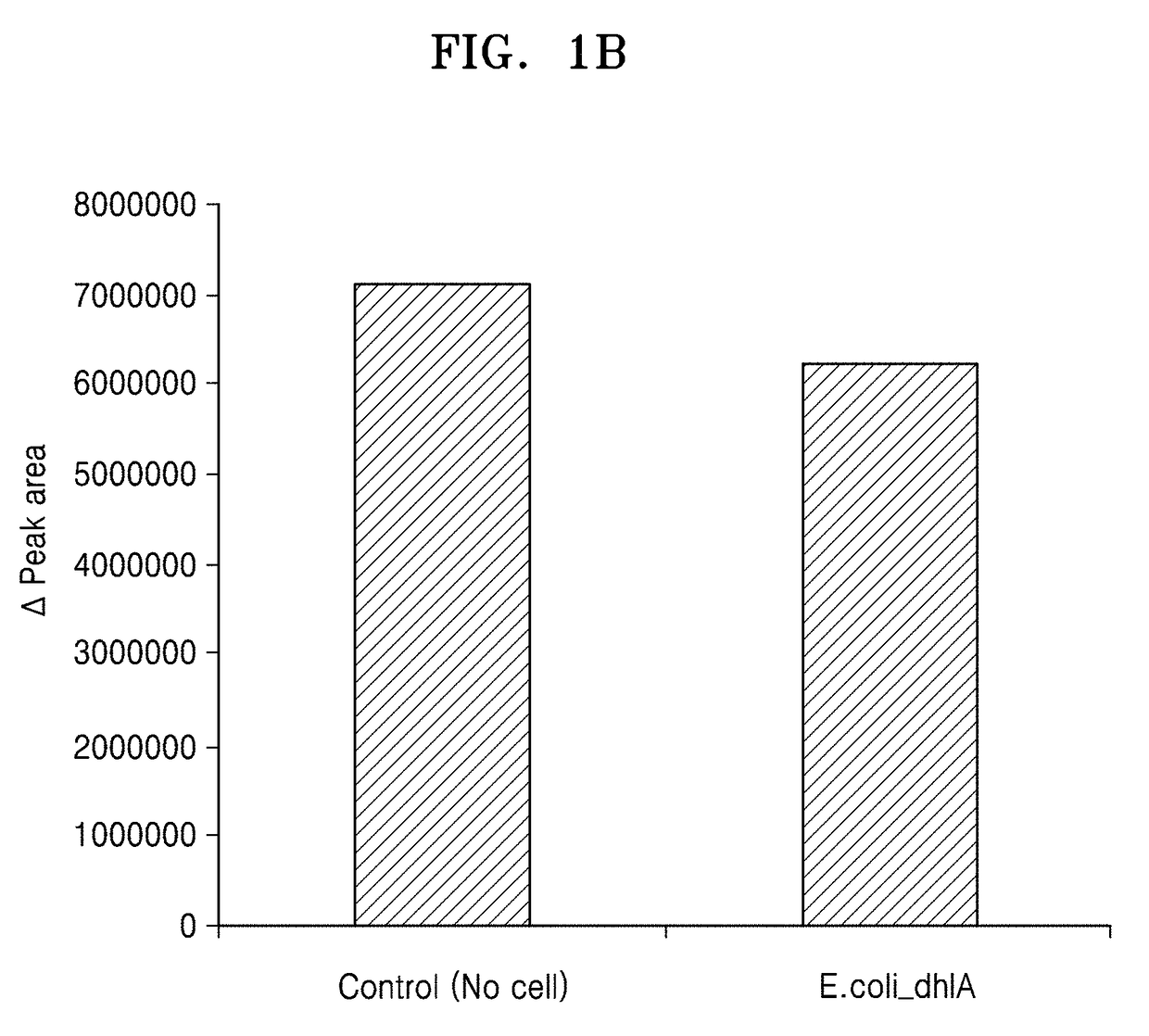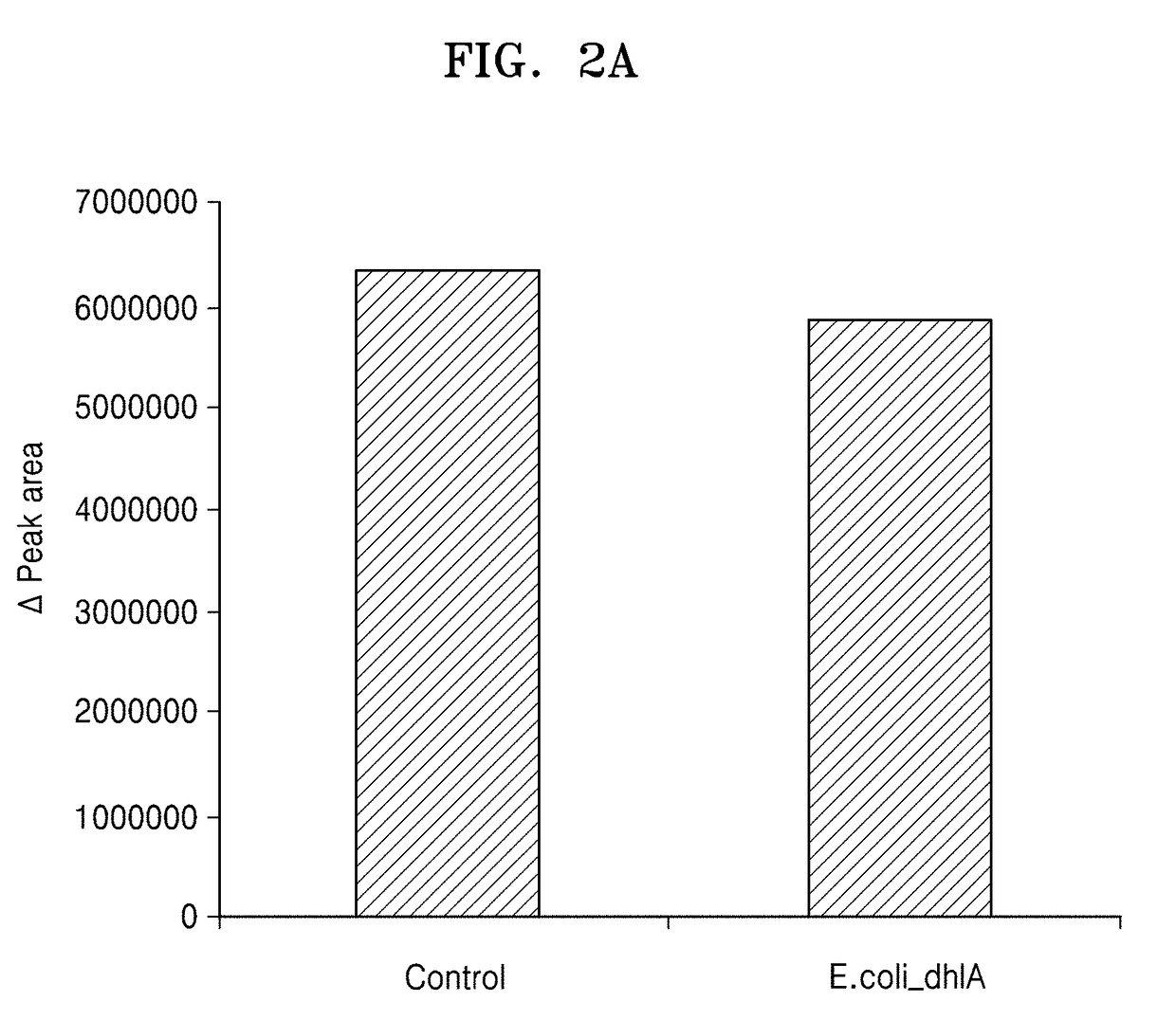Microorganism including gene encoding protein having dehalogenase activity and method of reducing concentration of fluorinated methane in sample using the same
a technology of dehalogenase activity and microorganisms, which is applied in the field of microorganisms including gene encoding proteins having dehalogenase activity and the field of reducing the concentration of fluorinated methane in samples using the same, can solve the problems of high global warming potential, long half-life, and emission of greenhouse gases, so as to reduce the concentration of fluorinated methan
- Summary
- Abstract
- Description
- Claims
- Application Information
AI Technical Summary
Benefits of technology
Problems solved by technology
Method used
Image
Examples
example 1
tion of Fluoroform by Dehalogenase-Introduced E. coli
[0050](1) Introduction of Dehalogenase Gene into E. coli
[0051](1.1) Introduction of dhlA and dhlB Genes
[0052]Haloalkane dehalogenase (dhlA) and (S)-2-haloacid dehalogenase (dhlB) of Xanthobacter autotrophicus GJ10 were selected as enzymes having activity of decomposing fluoro-containing hydrocarbon. Xanthobacter autotrophicus GJ10 was purchased from German Collection of Microorganisms and Cell Cultures (DSMZ).
[0053]A gene encoding haloalkane dehalogenase(dhlA) (SEQ ID NO: 3) and a gene encoding (S)-2-haloacid dehalogenase(dhlB) (SEQ ID NO: 4) were inserted into Ndel and HindIII sites of a pET28a vector (Novagen), respectively to obtain a dhlA-expressing vector, pET28a_dhlA and a dhlB-expressing vector, pET28a_dhlB. These vectors were introduced into E. coli, respectively and then their introduction was confirmed by sequencing. The haloalkane dehalogenase-introduced E. coli and (S)-2-haloacid dehalogenase-introduced E. coli were ...
example 2
tion of Tetrafluoromethane by Dehalogenase-Introduced Xanthobacter autotrophicus
[0066]PCR was performed using a genomic sequence of Xanthobacter autotrophicus GJ10 purchased from German Collection of Microorganisms and Cell Cultures (DSMZ) as a template and a set of primers having nucleotide sequences of SEQ ID NOS: 7 and 8, and a dhlA gene (SEQ ID NO: 3) thus amplified was introduced into a pTSa vector using an In-Fusion HD Cloning Kit (Clontech) to prepare a pTSa_DhlA vector (SEQ ID NO: 9) (ORF:2982-3914).
[0067]The vector thus prepared was transformed into X. autotrophicus GJ10 strain by electroporation, and a strain confirmed to have the dhlA gene was designated as Xantho_dhlA. This strain was cultured in a 250 mL-plastic flask containing 50 mL of M9 medium at 30° C. under stirring at 230 rpm overnight.
[0068]A 25 ml-serum bottle containing 10 ml of 2×109 cells / ml of Xantho_dhlA in the M9 medium and 600 ppm or 1000 ppm of CF4 in the headspace was incubated in a shaking incubator ...
PUM
| Property | Measurement | Unit |
|---|---|---|
| thickness | aaaaa | aaaaa |
| length | aaaaa | aaaaa |
| length | aaaaa | aaaaa |
Abstract
Description
Claims
Application Information
 Login to View More
Login to View More - R&D
- Intellectual Property
- Life Sciences
- Materials
- Tech Scout
- Unparalleled Data Quality
- Higher Quality Content
- 60% Fewer Hallucinations
Browse by: Latest US Patents, China's latest patents, Technical Efficacy Thesaurus, Application Domain, Technology Topic, Popular Technical Reports.
© 2025 PatSnap. All rights reserved.Legal|Privacy policy|Modern Slavery Act Transparency Statement|Sitemap|About US| Contact US: help@patsnap.com



